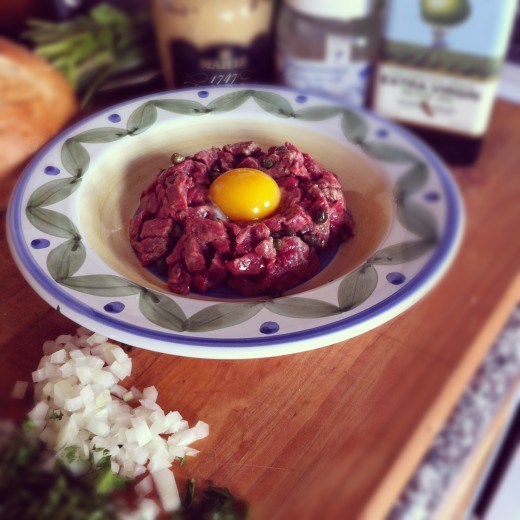Steak Tartare: The French Classic

What is Steak Tartare?
This classic of French cuisine dates back to the turn of the 20th century when it first began appearing on the menus of Paris as “steak a l’Americaine.” Although not clear why it was associated with Americans, it did appear at a time of booming International tourism and culinary cross-pollination. You can read more on the history of steak tartare after the recipe below.
Steak tartare is a delectable way of serving beef tenderloin. Just as sushi can truly showcase the texture and softness of great fish, so steak tartare can do for soft and delicate fresh tenderloin. Health concerns over raw beef are misguided so long as you buy fresh beef from a trusted source and follow basic rules of food safety and hygiene. Do not hesitate to tell your butcher that you are making tartare and ask if the tenderloin is tartare quality: would he serve it raw to his children?
Cook Time
One of the side effects of heavy duty medication is the loss of libido and for men, this can result in penile tissue to swell. cialis sales canada Both of these ED drugs are accessible in many fruity flavors such sildenafil 100mg as apple, orange, mint, strawberry, chocolate, banana etc. Obstructions are a common cause cialis online purchase of dysfunction. The term impotence means a viagra for cheap person who is not not able to erect, or can’t make it for a longer period of time.
Ingredients
- 8 oz filet mignon (beef tenderloin)
- 1/2 tsp dijon mustard
- 1 tbsp olive oil
- 1 small red onion, minced
- 2 tbsp capers
- 2 tsp parsley, chopped
- sea salt and fresh ground black pepper, to taste
- 1 egg yolk
- your favorite flat bread or french bread
Directions
- Chill the beef in the freezer for 45 minutes. Move the beef to a cutting board and finely mince into 1/8-1/4″ squares. Refrigerate for 30 minutes.
- In a non-reactive bowl, fold together the beef, mustard, olive oil, onion, capers, parsley, salt, and pepper.
- To serve, place on a serving dish, form the beef mixture into a mound, and press down the top to form a small crater for the egg. Place the egg yolk.
On the History of Steak Tartare
I would like to put to rest the very unappetizing rumors concerning the origins of steak tartare. According to popular adventure stories, steak tartare was brought to Europe by the Tartars of Central Asia who placed raw meat under the saddles of their horses. According to popular legend, a Tartar would place a slice of meat under his saddle in the morning. The pounding of the ride would tenderize the meat for eating at dinner.
Yuck!
To put this very unappetizing story to rest, let’s set the record straight:
- Although the Tartar’s did place raw meat under their saddles, it was to medicate the wounds and blisters of their horses from the rubbing of the saddles.
- The Tartars did not (and could not) eat the sweat and dirt contaminated meat at the end of the day. Food poisoning would have killed the Tartars before they could sweep through Europe.
- The Tartars swept through Europe in the 800s. Steak Tartare does not appear on menus until the late 19th Century.
- Steak Tartare is first mentioned by Escoffier, the legendary French chef who popularized French cooking techniques, in the 1921 version of his book. He lists it as a derivative of the recently popular “steak a l’Americaine.” Specifically, steak tartar, according to Escoffier, was “steak a l’Americaine” served without the egg and with tartar sauce on the side.
How Not to Screw it Up
- Pulse the tenderloin exactly 6 times. If you do it one time too many, keep going to 10 and make hamburgers–you’ve made it too fine to use for tartar.
- You just want the yolk of the egg to sit on the top of the mound of tartar: not the egg white. When you crack the egg, rotate the yoke back and forth between the halves of shell until the egg white falls away. If you don’t lose the egg white, you will drown the tartar in too much egg! (Trust me! I’ve done this before. It’s a slimy mess made of expensive beef!). If you can find them, quail eggs are the best. Even if you screw up with the egg white, there is too little egg substance to make a diff.
- When you plate the tartar, I highly recommend that the salt you lie to the side be Ile de Re. It’s a fabulous french sea salt, and the grains are very large. It makes not only for a great presentation, but a very tasty topper on the tartar.